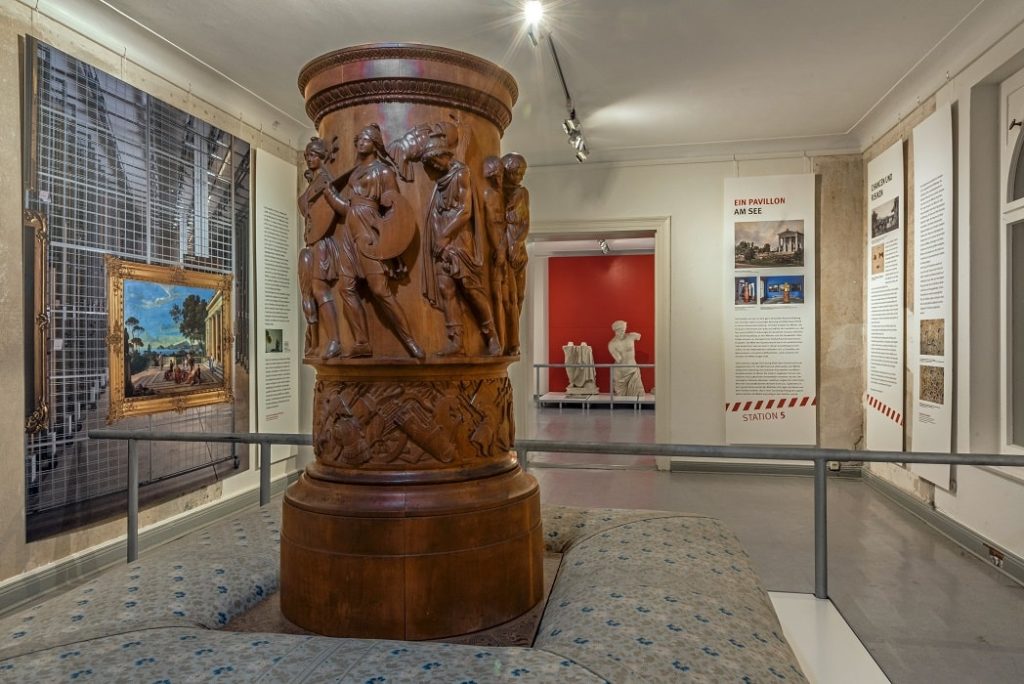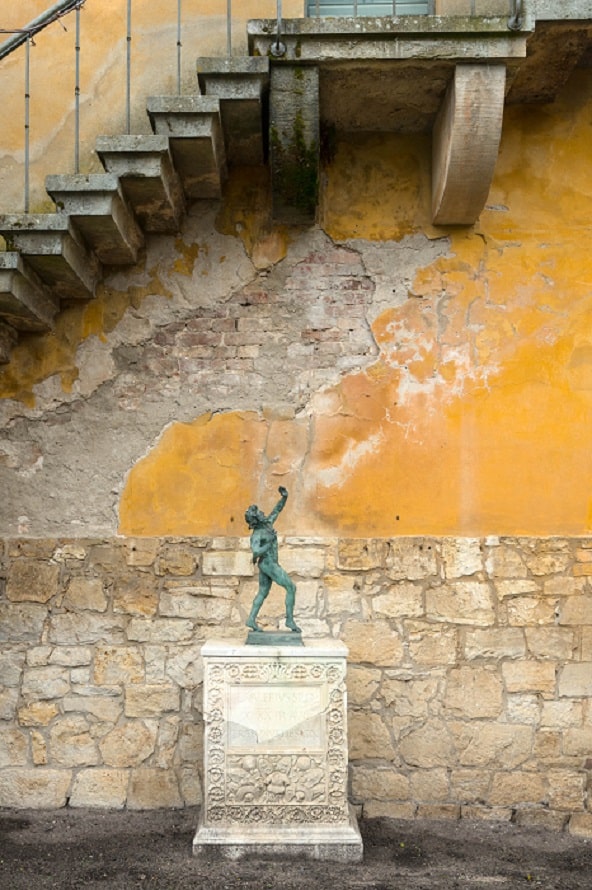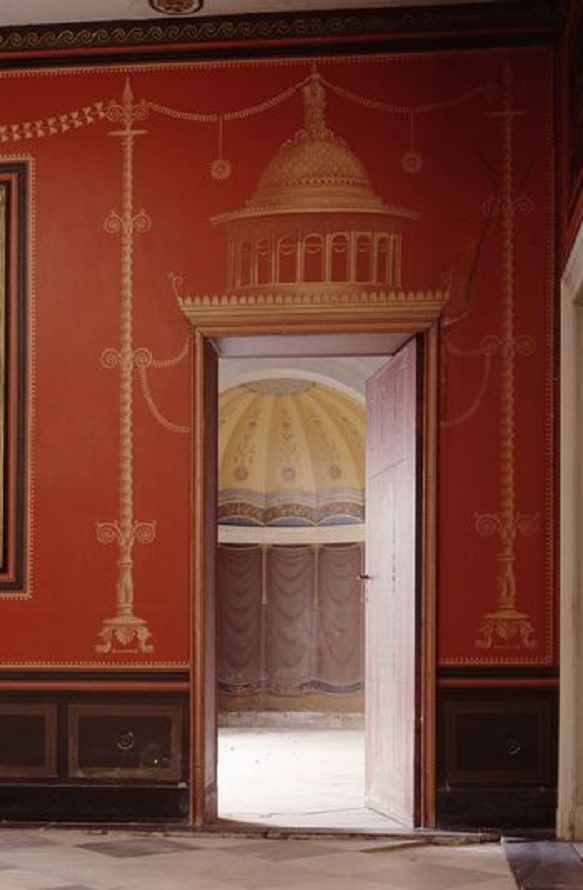Exhibition on the annual theme “World Heritage: Building and Preserving for the Future” in Potsdam’s Sanssouci Park from 1 May to 31 October 2022
image above: Römische Bäder: Blick vom Atrium in die Vorhalle des Viridariums. © SPSG/Hagen Immel
As part of the annual theme “World Heritage: Building and Preserving for the Future”, visitors to Potsdam’s Sanssouci Park, a UNESCO World Heritage Site, can expect a special attraction. From 1 May to 31 October 2022, the Prussian Palaces and Gardens Foundation Berlin-Brandenburg (SPSG) will be showing the exhibition “DENK × PFLEGE. Future for the Roman Baths World Heritage Site”. Afterwards, the building and garden complex will be closed for several years for urgently needed renovation and restoration work.

The exhibition takes visitors on a tour of the Roman Baths ensemble. For the first time, visitors will be able to see rooms and areas that have not been accessible for years. For example, the temple-like pavilion by the pond is open, as is the former billiard room and the anteroom to the so-called Viridarium – an inner courtyard reminiscent of an ancient Roman villa. Also on display are unrestored furnishings from the Roman Baths, sculptures and furniture that have been waiting in the depot for years to be displayed again in the restored rooms. The exhibition addresses the various aspects and challenges associated with the restoration of a high-ranking monument. At 15 stations, the public learns all about the work of the SPSG in the field of monument conservation using the example of the concrete need for restoration in the Roman Baths.
For example, how can a listed building be made barrier-free? How do you repair a cracked tile in a UNESCO World Heritage Site? How do fire protection or air conditioning systems work in a castle? What is sustainable and what is economically justifiable, and how much planning and work actually goes into a renovation project? The exhibition explains the methodical procedure in the planning phase, the problem analysis and the consideration of possible solutions. For there are rarely clear-cut solutions to the extremely complex issues. In the field of tension between maximum monument preservation on the one hand and adaptation to current uses and regulations on the other, every intervention must be carefully weighed up and justified. In addition, there are always new possibilities in terms of construction technology, but these must be critically examined with regard to their sustainability, economic viability and interaction with the monument substance. These tasks can only be mastered in interdisciplinary, long-term teamwork.

The exhibition is deliberately not aimed at a specialist audience, but at anyone who is interested. After all, they often only see the shells and construction signs of the SPSG’s major building projects in the parks and palaces.
The renovation of the Roman Baths, which will begin in 2023, is scheduled to last until 2025 and is part of the second special investment programme for Prussian palaces and gardens (master plan), which the federal government (The Federal Government Commissioner for Culture and the Media) and the states of Brandenburg (Ministry of Science, Research and Culture) and Berlin (Senate Department for Culture and Europe) have launched to save important monuments of the Berlin and Potsdam cultural landscape until 2030.
Longing for Italy – the Roman Baths in Sanssouci Park
While still Crown Prince, Frederick William IV (1795-1861) first commissioned Charlottenhof Palace (1826-1829) and then the Roman Baths. Inspired stylistically by Roman and ancient Italian models, the Roman Baths were built by Karl Friedrich Schinkel (1781-1841) and his pupil Ludwig Persius (1803-1845) between 1829 and 1841. The ensemble reflected in a special way the “longing for Italy” of the builder, who had influenced the architects’ plans with numerous ideas and design drawings. The redesign of the park landscape surrounding Charlottenhof Palace and the Roman Baths was the responsibility of Joseph Peter Lenné (1797-1866).
The gardener’s house was built in the Italian country house style in 1829/30, followed by the assistant’s house in 1832. Both buildings are connected by an arcade, an alcove and the wine arbour (1833) with a resting place in the style of a stibadium. From 1834 onwards, under Persius’ direction, the actual bath complex (Thermen) was built behind Schinkel’s arcaded hall (1832/33), which now functioned as a showcase. The wall paintings, which were completed by 1850, also testified to an intensive study of the excavations in Pompeii. However, bathing never took place in the Roman Baths.

The site is surrounded by water on two sides: The man-made engine pond in the south, whose name derives from a steam engine house that existed here until 1923, and the sheep moat in the east. The asymmetrical design allowed for open areas that were laid out as gardens or resting places.
The gardener’s house, in which the court gardener Hermann Sello (1800-1876), responsible for the surrounding park, lived, is a two-storey, staggered plaster building with a flat gable roof and attached pent roof as well as a laterally offset tower. The helper’s house, which was once quarters for the garden staff, is a two-storey plaster building with an enclosed courtyard and 2 gable roofs of different heights (with copper sheet roofing).
The arcaded hall on the north side of the garden courtyard originally served as an orangery. The bath complex (thermal baths) at its rear is a single-storey plaster building with various roof forms and copper sheet roofing. The asymmetrical group of rooms inside with atrium, open forecourt and thermal hall supported by caryatids (sculptures of women) is furnished in the Pompeian style. The atrium here is a reception room. The Pompeian painting is based on a design by Schinkel. The walls are painted a strong red over a black base and show sculptural groups of figures. The two marble statues were found in Pompeii and added around 1840. The decorative tub made of green jasper was a gift from Tsar Nicholas I (1796-1855) to Frederick William IV. The Impluvium, actually a collection basin for rainwater in the atrium, is in this case the name of the room behind the atrium. The Viridarium (green or cold house) presents itself as a small garden courtyard. Only the apodyterium (dressing room) and the caldarium (warm bath) correspond to the room designations of a Roman thermal bath. In the rear wall of the caldarium is an exedra (niche-like room). The Alexander mosaic, made of ceramic tiles, is currently in storage due to floor subsidence. The billiard room is the only room in the bath complex that served a specific purpose.
On the north bank of the machinery pond stands the tea pavilion, built in 1830 in the style of a prostylos (Greek temple), with a pillared portico and a copper-covered gable roof. It is connected to the gardener’s house by a pergola with a cellar. To the west of the tea pavilion, a square fountain is located in the memorial garden (1834) between two aedicules (“temples”) with busts of King Frederick William III (1770-1840) and Queen Luise (1776-1810).

The Special Investment Programme (Master Plan)
With the second Special Investment Programme for Prussian Palaces and Gardens (SIP 2, Master Plan), the federal government (The Federal Government Commissioner for Culture and the Media) and the states of Brandenburg (Ministry of Science, Research and Culture) and Berlin (Senate Department for Culture and Europe) are saving essential monuments of the Berlin and Potsdam palace landscape from decay. Under the agreement, the SPSG will be able to invest a total of an additional 400 million euros in saving national cultural assets by 2030. The federal government contributes 200 million euros (50 per cent), the state of Brandenburg.
131 million euros (33 per cent) and the Land of Berlin 69 million euros (17 per cent). Over the next five years, approximately 25 of a total of 60 projects are to be started or implemented.
WHEN?
Sunday, 1. Mai until Monday, 31. October 2022
Opening hours: Tuesday-Sunday, 10:0-17:30, last admission 5:00 p.m.
WHERE?
Römische Bäder
Park Sanssouci
14471 Potsdam
COST?
5 Euro, reduced 4 Euro






